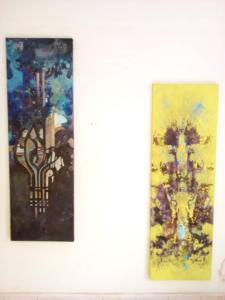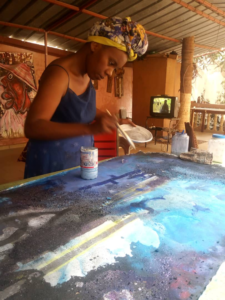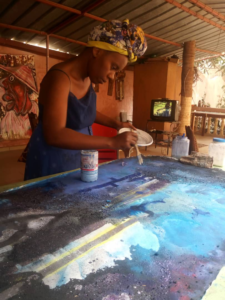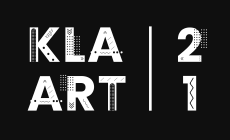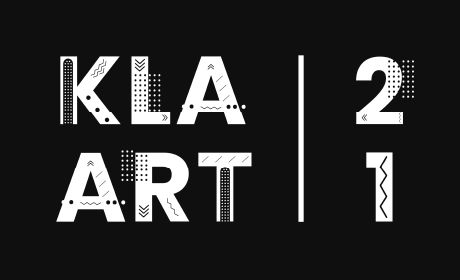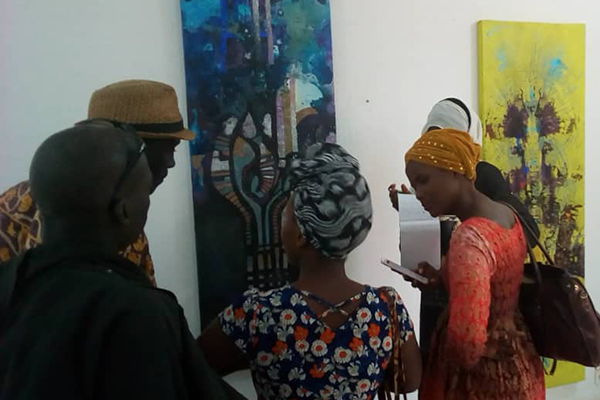
Charity Atukunda, Centre Soleil d’Afrique — Mali
There is a satisfaction I gain from visiting other African countries, there is the reassuring familiarity of seeing faces like mine, discovering similar customs like mine, I take pleasure in noting where they differ or where they have remained the same. I also enjoy delving in the unfamiliar, recognizing and appreciating how each culture on the continent and its dynamics are still so unique. My experience in Mali during my residency was really spent discovering the nuanced aspects of everyday life, interactions with a variety of people, learning the greater truths of its culture and also as a means to understand my own identity in a much wider context. For my creative work I was mostly curious learning new techniques (painting, textiles, sculpture etc) and hoping to gain a deeper understanding of the lives of women and how much freedom they have in their culture.
In the first workshop I attended, organized by our hosts Centre Soleil D’Afrique, I started to speak to the women that I met in the group. One of the young women after answering most of my questions( in French) finally commented on my features and appearance. She called me ‘peuhl’, ‘whats that?’ I asked and she started to explain to me about the groups of people I resemble, she ended with the final example of ‘ you look like Kagame’s people’. It was a bit unsettling that even so far away from Uganda, I was immediately classified. Given the violence and horror that the Hamitic theory had on Africans through colonial powers, it was unsettling that it was still ever so present.
Mali was a well established nation before the French arrived, as I walked through the National Museum showcasing masks, ideograms (symbols used for communication), textiles, carvings, amulets, replicas of the traditional architecture of Timbktu and Djenne, I take satisfaction in noting that the colonialist had not penetrated this culture but it also hurts to know that they profited from it heavily and still do. What impresses me in the large museum is just a small portion compared to what is held in European museums.
I learned over time that women have different kinds of freedom than what I have experienced in Uganda and the narratives I hold are challenged and enriched. At a festival in Segou along the Niger River I sit in a tent with Taureg Women who serve sweet tea, they are pleased that someone all the way from Uganda came to Mali. I later learn that their society is matriarchal, it’s the men who cover their faces only showing them to their lovers. Mobility is practical and not gendered in Mali, everyone drives, a car or drives a scooter. It’s amazing to see women dressed in their finest outfits, glittering headscarves and high heels occupying the roads just as the men do. I take note that few bars sell alcohol, very few women go to bars, if they do they are always well dressed, sequined tight dresses and drink sodas, an artist I met corrects me, everyone drinks alcohol but in secrecy, there is always live music in bars, full bands and each performance is riveting with a Korra at the centre of the melodies. Every meal is communal, platters of rice, couscous, fish, gnuts, goat meat, chicken okra, chilis, onions, pawpaws, eggplants, the women are always in the kitchen.


It’s something I know well, I make the connection and decide to incorporate it into my work. I had hoped to take up painting again during the residency having thrived the last few years creating mainly digital work. I was longing for something tactile, texture, after learning a technique called tchin tchin bari (sand painting) I decided to create my own compositions with the materials that pass through women’s hands, the black charcoal dust that stains our clothes and kitchen walls and the glitter, the makeup that we decorate our bodies with when we emerge from our homesteads, to partake in the rituals of society.
